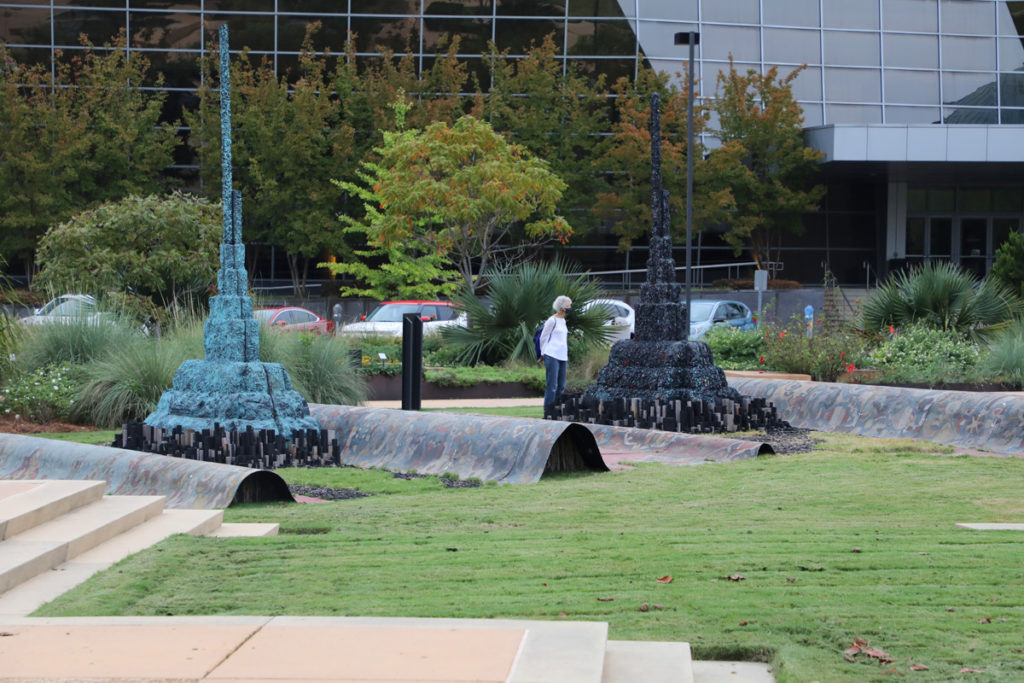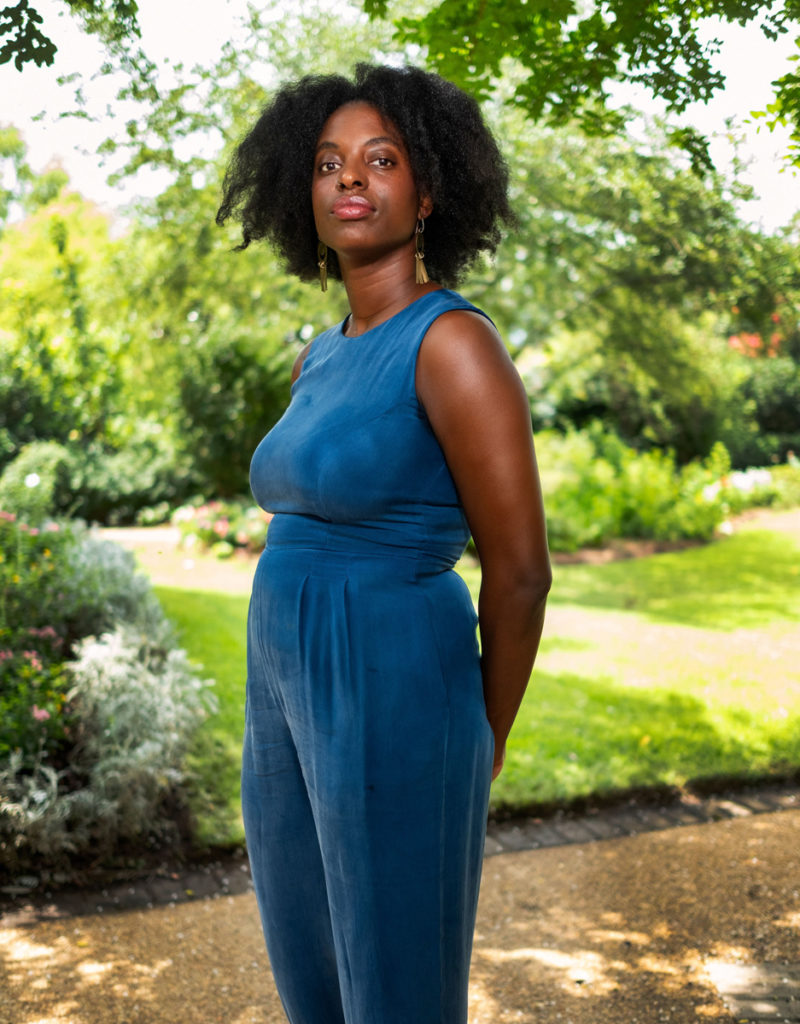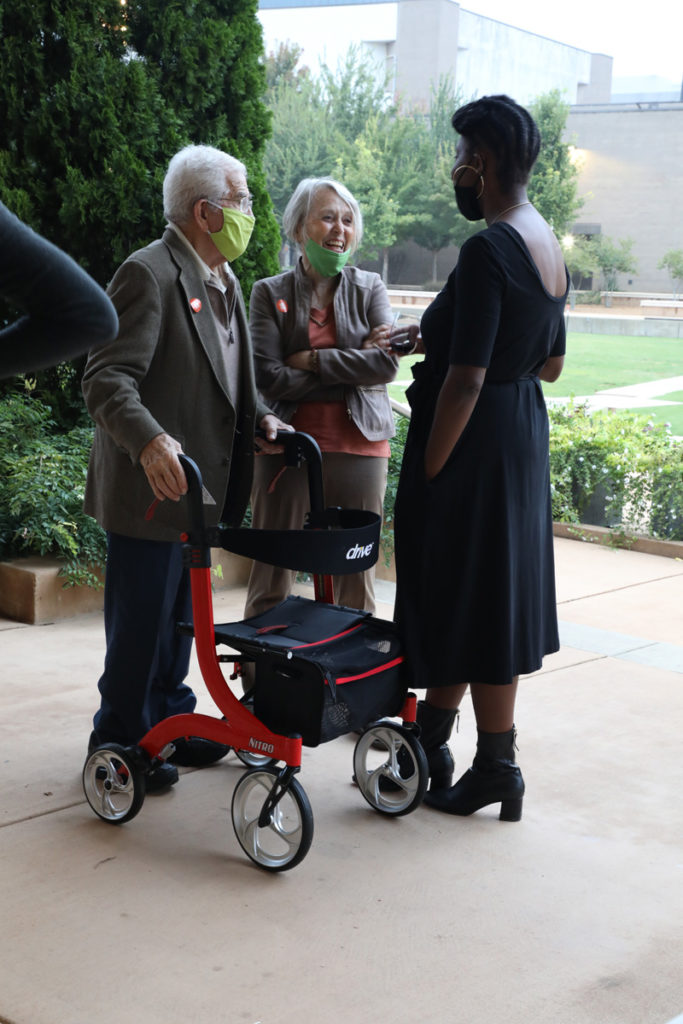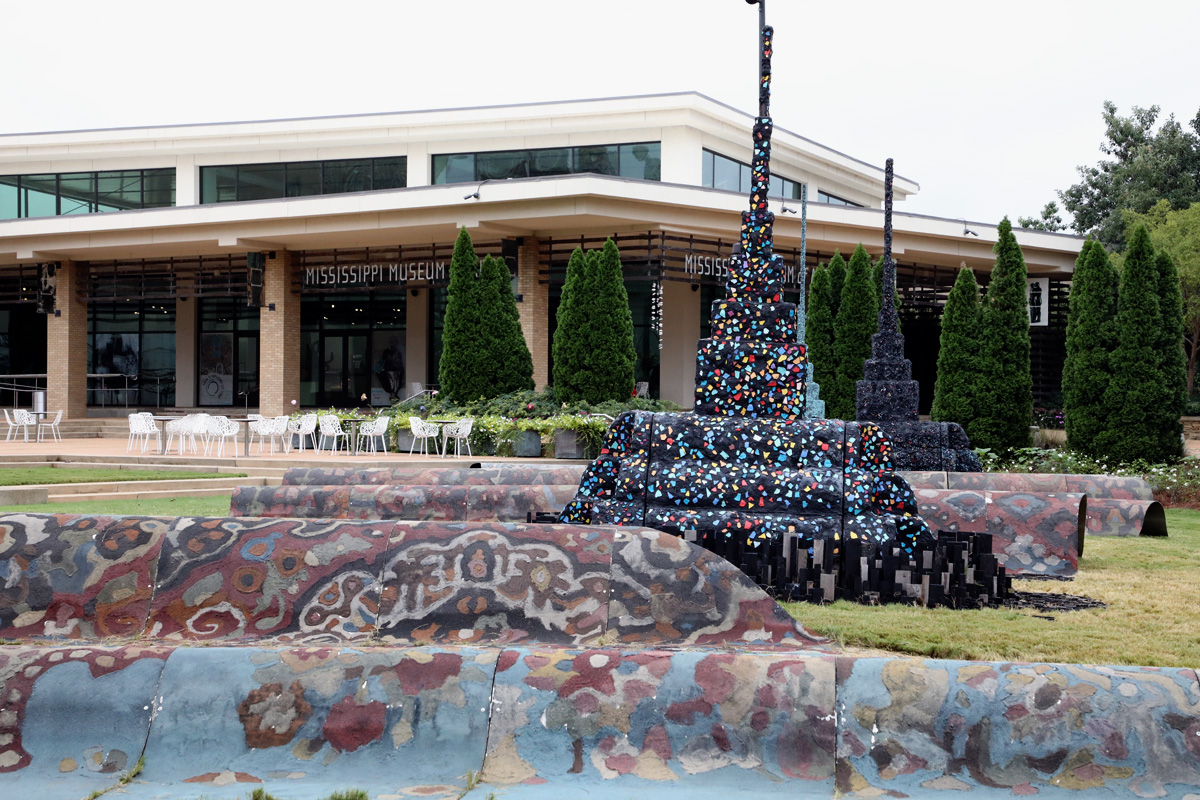Skyscraper spires jump up from the grass as a richly patterned wave undulates between them, punctuating The Art Garden at the Mississippi Museum of Art with a fanciful invitation to explore.
Go ahead. “Leonardo Drew: City in the Grass,” on view through Feb. 21, is a sculpture that beckons to be touched, sat on, walked around (even upon) and inspected up close and personal. Like a magic carpet ride, it can whisk the imagination off on a journey where viewers, like Gulliver from “Gulliver’s Travels,” can roam, loom over, lounge around and hang out in the cityscape, interacting directly with it.
“I just thought it was magical. I love the way he plays with scale,” says Mississippi Museum of Art Director Betsy Bradley, who first saw the sculpture at Madison Square Park in New York City in 2019. The monumental public art project, commissioned by Madison Square Park Conservancy, was the Brooklyn-based artist’s most ambitious to date. It was previously on view, too, at the North Carolina Museum of Art.

“It was such an interesting and playful, yet serious treatment about urban life and imagination and seeing things from different perspectives. … It’s about the visitor, the person, being part of the experience, and not just looking at something on a wall,” she says. “The person walking through it is necessary for the artwork to come to life.”
In that way, it works, too, as a physical embodiment of the museum’s goal of public engagement. “There’s no barrier to it, so anyone can walk up at any time and experience it,” Bradley says, with readers relaxing and dancers leaping upon its Persian carpet-like rolls in past installations.
The Mississippi Museum of Art’s recent hire of Ryan Dennis, its first Black chief curator, is right in line with the institution’s focused progress on busting barriers and breaking down walls. Dennis, on staff since June, represents a high-profile step in its commitment for more diverse representation and greater community engagement.
Dennis is also the artistic director of the museum’s Center for Art & Public Exchange (CAPE), a W.K. Kellogg Foundation-supported initiative to use art, exhibitions, programs and more to deepen understanding and inspire new narratives in contemporary Mississippi. The two roles, both with aims of engagement and representation by artists of color, women and the LGBTQIA community, work together, Dennis says.
A Texan by birth, Dennis grew up in San Antonio and returned to her native Houston for undergraduate studies.
With the Mississippi Museum of Art position, “It seemed like the stars aligned,” Dennis says, taking the work, creativity and passion she put into Project Row Houses (eight years professionally, the last several as curator and programs director), and amplifying it. Project Row Houses is a community-based arts organization in Houston’s Third Ward, one of its oldest African American neighborhoods, that’s deeply invested in both connections with residents and collaborations with contemporary artists.
The museum’s interest in social and racial justice, and its aim to expand representation of artists of color and women in the permanent collection and exhibitions, resonated. The job’s possibilities “seemed like a wonderful next step,” Dennis says.

Dennis came recommended for the museum’s newly combined position. “I was really impressed with how she married creating art programs with deep community engagement,” says Bradley, who had known about Project Row Houses for years as one of the original community-based, creative place-making projects. “I knew that if she was doing that kind of work there, that she would fit our goals of inclusion and community engagement and equity. And, her voice is just an original, very interesting voice to be leading both CAPE’s programming and the museum’s artistic vision.
“The work that we do needs to reflect the people in our community, and we’re in a community that has a large African American population, and she can engage that experience and that identity and that perspective in a way that we’ve never been able to do before.”
The Jackson museum’s increased emphasis on art as a lens for communication and a tool for connection take it far beyond a beauty and decor veneer.
“I think visionary leaders and vulnerable leaders have a desire to follow the ways that artists are working,” Dennis says. She is eager to see artist responses to the current social and political climate, and discover how it is impacting their thoughts and their work.
“I’m very excited to see what comes out of this moment, but also really inspired by some of the ways that I’ve seen artists working in a more, kind of, political framing. … Historically, it’s been present, but things take time to come out in the public sphere in a really impactful way.”
Time, and a specific type of framing, she adds. While an organization like Project Row Houses might be more nimble and flexible to respond to events such as the killing of George Floyd and subsequent protests, an institution such as a museum is less so; but committed directors and staff work hard to overcome the hurdles and address a history fraught with underrepresentation and more.
“I’m patient, but also … I’m also an active respondent of this moment in time.”
A longtime admirer of Drew’s work, Dennis is the organizing curator for “Leonardo Drew: City in the Grass.”

Upcoming at the museum, look forward to a Dusti Bongé retrospective from the Ogden Museum of Southern Art, Freedom Rider paintings and more by artist Charles Williams who’s conducting a CAPE residency in McComb and “Betye Saar: Call and Response” from the Los Angeles County Museum of Art.
For now, the sculpture in The Art Garden is a well-timed treat for Jackson-area art lovers, with its tangible access during a pandemic that’s kept people at arm’s length for months.
“Honestly, it’s pretty timely,” Dennis says, “given COVID and people’s comfort levels of coming inside the museum. It’s nice to have an artwork that people can come to and be with their families and engage in, if they feel uncomfortable stepping into the doors right now.”
She hopes it gives viewers and participants more insight into Drew’s practice and his work on large-scale, immersive paintings and sculptures. “My greatest hope is that people come and interact with the work … not feel nervous to step into the work and to take selfies…get comfortable and participate.
“Leonardo really intended it to be this kind of wondrous, imaginative moment for people to just get lost. And I think, given the moment we’re in … I think we all want to do that.”
This MFP Voices essay does not necessarily represent the views of the Mississippi Free Press, its staff or board members. To submit an essay for the MFP Voices section, send up to 1,200 words and factcheck information to donna@mississippifreepress.com. We welcome a wide variety of viewpoints.






